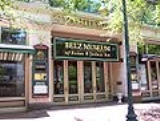
Belz Museum of Asian and Judaic Art
Encyclopedia
The Belz Museum of Asian and Judaic Art is located at 119 South Main Street at the intersection of Gayoso Avenue in Memphis
, Tennessee
, USA
. The museum was opened in 1998 as the Peabody Place Museum and in January 2007 it received its present name.
The museums collection is based on the private collection of Memphis developers Jack and Marilyn Betz, who owned the Peabody Hotel
and Peabody Place
. The Belz features over 1,000 objects, including works of jade
, tapestries, furniture, carvings, and other historical and artistic objects. The museum also houses one of the finest collections of pieces from the Qing dynasty
.
Memphis, Tennessee
Memphis is a city in the southwestern corner of the U.S. state of Tennessee, and the county seat of Shelby County. The city is located on the 4th Chickasaw Bluff, south of the confluence of the Wolf and Mississippi rivers....
, Tennessee
Tennessee
Tennessee is a U.S. state located in the Southeastern United States. It has a population of 6,346,105, making it the nation's 17th-largest state by population, and covers , making it the 36th-largest by total land area...
, USA
United States
The United States of America is a federal constitutional republic comprising fifty states and a federal district...
. The museum was opened in 1998 as the Peabody Place Museum and in January 2007 it received its present name.
The museums collection is based on the private collection of Memphis developers Jack and Marilyn Betz, who owned the Peabody Hotel
Peabody Hotel
The Peabody Hotel is a luxury hotel in Downtown Memphis, Tennessee. The hotel is well known for the famous "Peabody Ducks" that live on the hotel rooftop, but which make daily treks to the hotel's lobby in a daily "March of Ducks" celebration.- History :...
and Peabody Place
Peabody Place (Memphis, Tennessee)
Peabody Place is a mixed use residential, retail, and office redevelopment project located in Downtown Memphis, Tennessee that covers eight city blocks....
. The Belz features over 1,000 objects, including works of jade
Jade
Jade is an ornamental stone.The term jade is applied to two different metamorphic rocks that are made up of different silicate minerals:...
, tapestries, furniture, carvings, and other historical and artistic objects. The museum also houses one of the finest collections of pieces from the Qing dynasty
Qing Dynasty
The Qing Dynasty was the last dynasty of China, ruling from 1644 to 1912 with a brief, abortive restoration in 1917. It was preceded by the Ming Dynasty and followed by the Republic of China....
.

